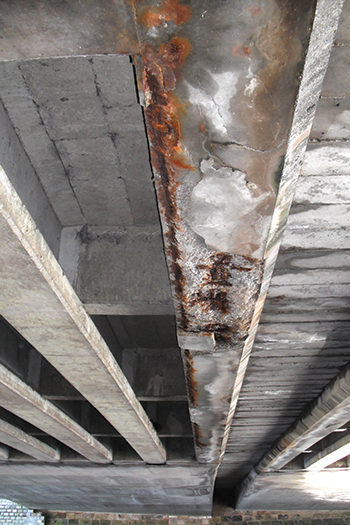
 Zinc dust paints, used to protect many bridges against corrosion, can be made more eco-friendly and effective by incorporating Dynasylan Sivo 140 binder.
Zinc dust paints, used to protect many bridges against corrosion, can be made more eco-friendly and effective by incorporating Dynasylan Sivo 140 binder.
Corrosion gnaws its way stealthily through bridges, machines and buildings, whether of metal, concrete, glass, or plastic. Germany-based Dechema, the Society for Chemical Engineering and Biotechnology, estimated annual global losses due to corrosion at an astounding €3.3 billion ($3.91 billion) some six years ago.
So corrosion is a drain on the wallet as well as on the surfaces of materials. But according to Dechema, appropriate protective measures could save up to 30 per cent of these costs, amounting to about €1 billion every year.
These figures clearly indicate that corrosion protection today is an issue that cannot be ignored. Nonetheless, established methods of surface treatment, including chromating and phosphating, are increasingly coming up against limitations and are seen ever more critical, mainly for reasons of environmental protection.
Application techniques for substances containing chromium (VI) are particularly problematic. The use of these substances is being banned in Europe in an increasing number of applications, through such provisions as the second RoHS Directive (Restriction of the Use of Certain Hazardous Substances in Electrical and Electronic Equipment) that came into force in 2013. The US, Japan, China, and South Korea have adopted similar regulations.
Chromium substitutes
Alternative methods for protecting metal surfaces against corrosion are, therefore, urgently needed, and these methods must be eco-friendly as well as reliable.
Developers at specialty chemicals company Evonik rely here on hydrolysed and condensed silanes that form a binder: the formulation of such binders results in eco-friendly corrosion protection systems.
During the curing process, a protective film with a thickness in the nanometre to micrometre range is formed. Although thin, the film is highly impervious and protects the underlying metal against water and corrosive substances. It can be formulated using other binders and fillers to form thicker corrosion protection systems.
Over the last years, Evonik’s specialists have developed, under the Dynasylan Sivo brand name, a series of binders that have proven their worth in a very wide range of materials and application methods.
Eco-friendly paints
Paints with an underlying zinc dust primer are the choice when long-term corrosion protection is called for, and other coatings have reached the limits of their capabilities. Typical application areas include transmission towers, industrial plants, bridges, and shipbuilding. The zinc dust in the paint deposits as a fine film over the surface of the materials, the particle density being so high that the individual metal particles are in contact with one another. The electrically conducting film so formed then serves as anodic corrosion protection.
The current challenge that zinc dust paints face is that they often use inorganic binders with high solvent content, which release volatile organic compounds (VOCs) while curing. This is seen as increasingly critical on the grounds of health and safety. Water-based zinc dust paints, on the other hand, are normally formulated with epoxy or alkyd resins, which do not tolerate excessive heat or ultraviolet (UV) radiation.
The water-based Dynasylan Sivo 140 binder developed by Evonik’s researchers combines the best of both worlds. Like the solvent-based inorganic binders, it is powerful and thermally stable. But it releases almost no volatile organic substances and is, therefore, as environment-friendly as the water-based zinc dust paints.
Dynasylan Sivo 140 was designed especially for use in two-pack zinc dust paints. It is formulated with the zinc dust as the second component and then cures at normal ambient temperatures. The organic-inorganic binder can easily be diluted with water without the generation of undesired ethanol; in addition, the active silanol groups are stabilised, ensuring optimal miscibility with fillers and pigments. Formulations can be adjusted for high or low dry film thicknesses, depending on the area of application.
When iron or steel rusts, an oxide film forms on the surface. This familiar iron oxide (rust) is porous. As a result, corrosion eats ever deeper into the metal. Many other metallic materials such as aluminium, zinc, and magnesium behave differently, interacting with air on the surface to spontaneously form an oxide film that, although thin, is impermeable to air. This passivation protects the underlying material from contact with oxygen and thus from further degradation. It may, nevertheless, be necessary to provide even these metals with additional corrosion protection if, for example, they come into contact with chloride.
Corrosion inhibition primers based on Dynasylan Sivo 160 are particularly suitable for protecting materials like aluminium, magnesium, and zinc-galvanised iron or steel against corrosion.
In contrast to the current solutions employed in this area, the binder contains neither heavy metals nor fluorides. These are highly objectionable from an environmental viewpoint and are not required in the formulation of the actual rust inhibition primer. A film thickness of just 100 to 200 nanometres of this water-based silane system is all that is needed to protect aluminium from further corrosion.
For use in exterior applications, the system is formulated with additional additives and stabilisers. Thanks to the high reactivity of the organofunctional silanol groups, curing can take place at temperatures as low as 60 deg C.
Dynasylan-based corrosion-control coatings have been tried and tested over many years, such as the Picasso Centre in Basel, Switzerland, and the “Gherkin” office tower in London, UK, as well as in protective paints on innumerable bridges and ships all over the world. In all these places, Dynasylan Sivo has offered a double benefit for the environment: directly, by releasing fewer volatile organic compounds, and also by increasing the service life of structures and installations as a result of its corrosion-inhibiting action. This prevents waste and represents a genuine contribution to sustainability.
* Dr Philipp Albert is director of Applied Technology Silanes for Coatings and Metal Treatment in Evonik’s Resource Efficiency Segment.





















_0001.jpg)


.jpg)
















.jpg)








.jpg)




